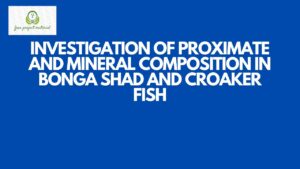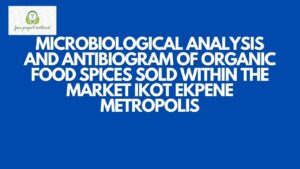ABSTRACT
Antimitotic effect of water yam leaves extract using ethanol and aqueous as extractants at different concentration on post-harvest pathogenic fungi woe investigated. Pathogenicity test revealed that fusarium oxysponim, Rhizopus stotonifer, Bacillus subtilis, and Aspergillums niger were the causal organism of deteriorations in the white yam tuber. Ethanol was more effective than aqueous extract in controlling the establishment of the test pathogens in vitro and in vivo. Ethanol extract exhibited the highest potency in inhibition with increase in concentration, this was attributed to the inherent biochemical constitution of water yam leaves extract that was found to contain alkaloids, tannins, flavonoids, saponins, and sterols. Aqueous extract had the minimum total inhibition. The possibilities that these leaves extracts used can serve as source of alternatives to chemical control of yam is quite obvious.
TABLE OF CONTENTS
Title Page
Certification
Dedication
Acknowledgements
Abstract
List of Tables
CHAPTER ONE
1.0 Introduction
1.1 Background of the Study
1.2 Aim of the Study
1.3 Scope and Limitations
1.4 Significance of the Study
CHAPTER TWO: LITERATURE REVIEW
2.1 Description of Water Yam (Dioscorea alata)
2.2 Nutritional Profile of Water Yam
2.3 Health Benefits of Water Yam Leaves
2.4 Uses of Water Yam
2.5 White Yam Pot (D. potindata)
2.6 Phytochemical and Antifungal Actions of Water yam Leaves
CHAPTER THREE:MATERIALS AND METHODS
3.0 Materials and Methods
3.1 Source of Yam species
3.1.2 Sterilization of Laboratory Materials
3.1.3 Preparation of Culture Media
3.1.4 Isolation of Associate Fungal Pathogens from rotted white yam tubers
3.1.5 Subculturing and Purification
3.1.6 Characterization of fungal isolates
3.1.7 Pathogenicity Test
3.1.8 Extract Preparation and Dilution
3.1.9 Antifungal Bioassay
3.2 Phytochemical Screening
3.2.1 Test for Tannins
3.2.2 Test for Saponins
3.2.3 Test for flavonoids
3.2.4 Test for Alkaloids
3.2.5 Test for Sterols
3.2.6 Test for Starch
CHAPTER FOUR: RESULTS AND DISCUSSION
4.0 Results and Discussion
4.1 Results
4.2 Discussion
CHAPTER FIVE: CONCLUSION AND RECOMMENDATIONS
5.0 Conclusion and Recommendations
5.1 Conclusion
5.2 Recommendations
References
LIST OF TABLES
Table 4.1: Frequency of occurrence (5) of isolated fungi from Rotten white samples
Table 4.2: Pathogenicily Test and mean percentage of rot by fungal
isolates on healthy white yams
Table4.3: Antifungal Effect of Test Fungi on Pathogens of Dioscorea alata Leaves Extracts (Ethanolic)
Table 4.4: Antifugal Effect of Test Fungi on Pathogens of Dioscorea Alata Leaves Extracts (Aqueous)
Table 4.5: Qualitative Phytochemical Analysis of Dioscorea Alata
Table 4.6: Quantitative Analysis of the Phytochemical Constituents of Dioscorea Alata
CHAPTER ONE
INTRODUCTION
1.1 Background of the Study
Yam is the common name given for species of the family Diocoreaceae and the genus Dioscorea. It is an elite staple crop in West Africa which has over the years contributed significantly to the overall nutrient intake of the populace. It is the third most important tropical root and tuber crop after cassava and sweetpotato. (Walsh, 2003).
Water yam leaves are used for nutrients culinary or for medicinal purposes. These plants belong to the sweat potato family which is why they share some of the same health benefits. Water yam leaves are a good source of vitamins A, B6, C and E, as well as minerals like potassium (Agbai, 1986). Water yam is a tuberous root vegetable originated in the Asian tropics. Its tubers are usually bright lavender in colour. Medicinally, it is used as a laxative and verfimuge and used to treat fever, gonorrhoea, leprosy, tumours, and inflamed haemorrhoids.
Dioscorea alata leaves are highly invasive plant outside cultivated areas. It is included in the global compendium of weeds, and is listed as a noxious weed in Florida. Water yam leaves extract can be used as a natural way of controlling post-harvest effects of white yam rot instead of using fungicides or other chemicals to prevent then spoilage of yam.
1.2 Aims and Objectives of the Study
The aims and objectives of this research work is to determine the potential of the leaves of dioscorea alata in controlling the rot of white yam.
The Objectives were:
- To Isolate and identify bacteria and fungi that causes post-harvest yam
- To determine the anti-microbial effect of water yam leaves against fungi that causes post-harvest yam rot.
- To make recommendation base on the results of this work.
1.3 Scope and Limitations This research look focuses on the effects of water yam (dioscorea alata) leaves extracts on the rot of white yam. It also focuses on the effect of the isolated microorganisms on a healthy yam tuber to test for pathogenicity.



